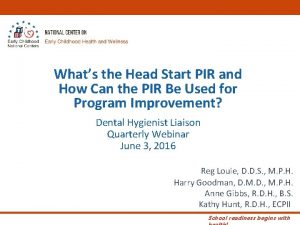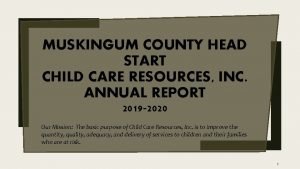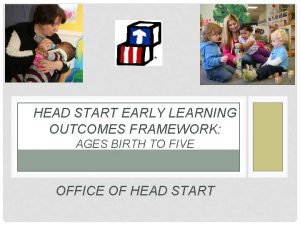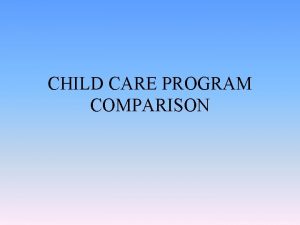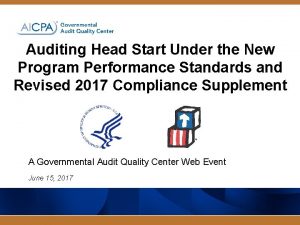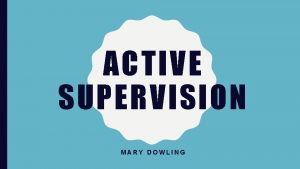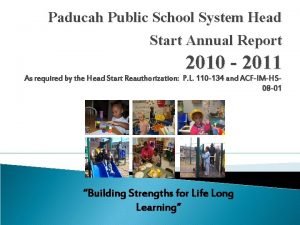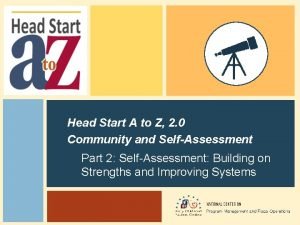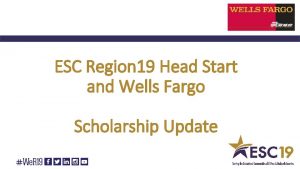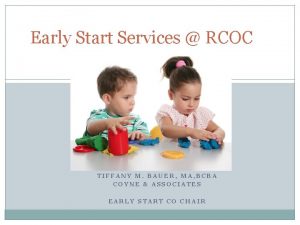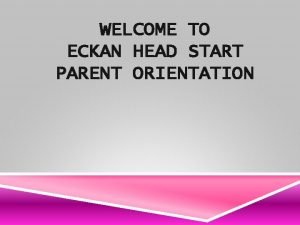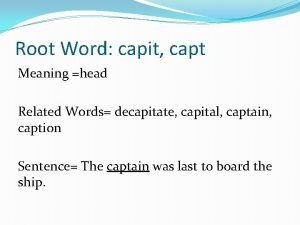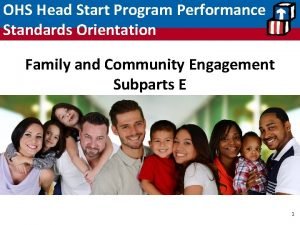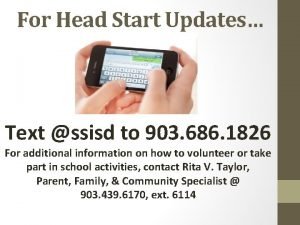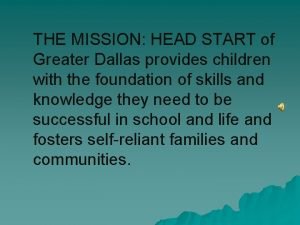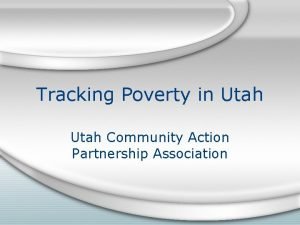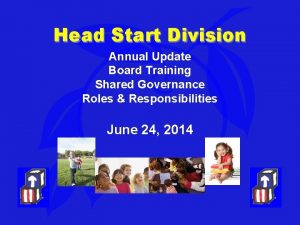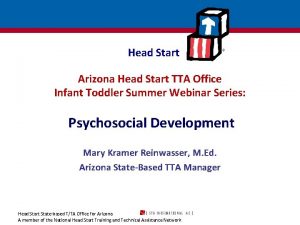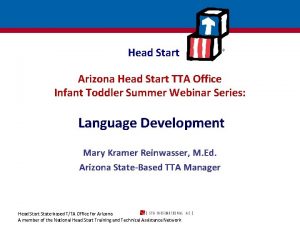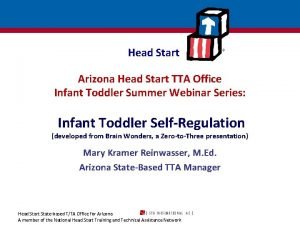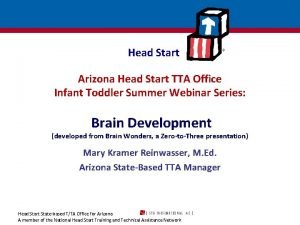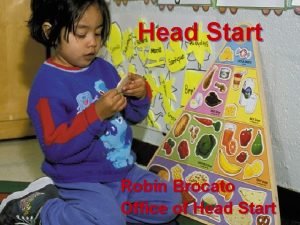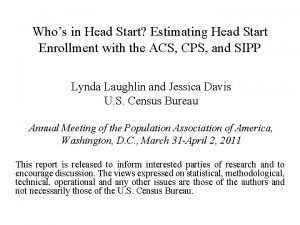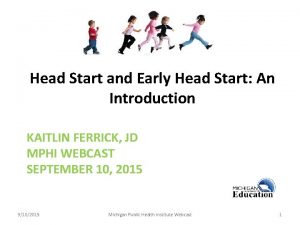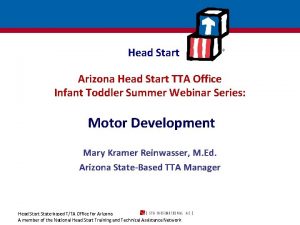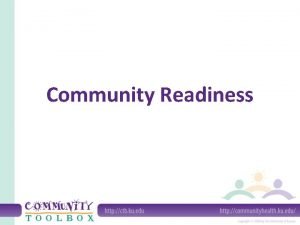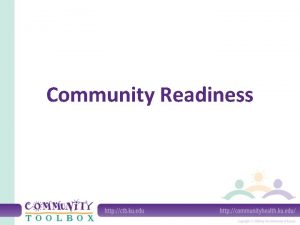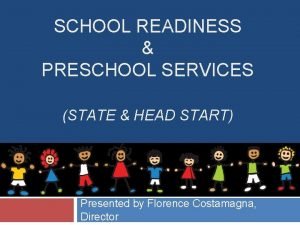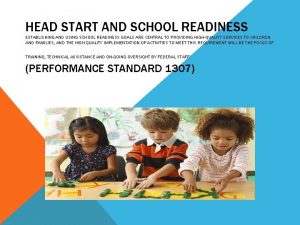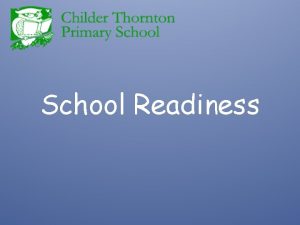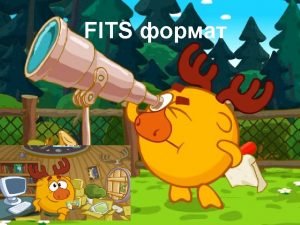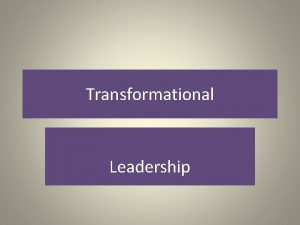Improving Head Start for School Readiness Act of





























- Slides: 29

Improving Head Start for School Readiness Act of 2007 P. L. 110 -134

Definitions l l l Deficiency Limited English Proficient Professional Development Unresolved area of non-compliance Interrater Reliability Scientifically Valid Research

Authorization Levels l l l FY 2008 FY 2009 FY 2010 FY 2011 FY 2012 $7, 350, 000 $7, 650, 000 $7, 995, 000 such sums

Grantee Designation l Grants will be for a 5 year period l A Secretarially appointed review panel will make recommendations on the implementation of a new system for redesignation of grantees. l 18 -36 month time frame for implementation

Funding Allocation All grantees must get prior year’s base funding level unless appropriation is less than prior year. If there are increased funds: l l l T/TA is 2 ½-3% of the increase Grantees get COLA equal to prior year increase in CPIU if there are sufficient funds Indian and migrant programs get $10 million or, if a full COLA is not possible, 5% of any increase. (0 if COLA is less than half the CPI-U)

Funding Allocation (continued) Of any remaining funds: l l l Quality Improvement – 40% (45%) Expansion – 45% (55%) State Advisory Councils – 15%

Funding Allocation (continued) l Quality funds – – l proportionate to grantee enrollment 50% for salaries to education personnel, family workers and child counselors Head Start Expansion funds At least 3% to Indian programs and 4. 5% to migrants. Remainder is split between Head Start and EHS. For Head Start allocation, expansion further split among all states and states serving less than 60% of 3 s & 4 s below the poverty line.

Funding Allocation (continued) l l ‘Discretionary payments’ capped at $42 million RD&E capped at $20 million State Advisory Councils capped at $100 million Special Expansion to AIAN and MSHS capped at $50 million for each

Homeless children l l Homeless children are categorically eligible for Head Start. OHS will issue regulations regarding the participation and prioritization of homeless children in Head Start programs.

Children above poverty line l l Up to 35% of a grantee’s enrollment may be children whose incomes are between 100135% of poverty. (This is in addition to the current 10% over-income. ) Grantees doing so must demonstrate they have fully met the needs of the low-income population in their service area.

Enrollment l l l Grantees can propose to convert current Head Start slots to EHS slots. (subject to regulations) Grantees can propose to convert current part-day slots to full-day slots. Grantees, if full COLA is not awarded, can propose enrollment reductions. Grantees are to maintain “an active waiting list”. AIAN grantees who run HS and EHS programs may reallocate funds between HS and EHS.

Children with disabilities l l l The current regulatory requirement that 10% of enrolled children has been modified and incorporated into law. 10% of enrolled children (not enrollment opportunities) must be for children with disabilities. Grantees may get a waiver but only for up to 3 years.

Curricula l All curricula must be based on scientifically valid research and be age and developmentally appropriate.

Standards l l OHS to review and, as appropriate, revise the Performance Standards to ensure children demonstrate: Ø Ø Ø Language knowledge and skills Literacy knowledge and skills Mathematics knowledge and skills Science knowledge and skills Abilities in the creative arts Physical development

Measures l OHS to provide guidance to grantees on the use of scientifically-based measures that: – – Help children develop the skills, knowledge, abilities and development related to achieving school readiness Improving classroom practices Identifying the special needs of children Improving overall program performance

Monitoring l l Teams do not have to be led by federal team leaders. Reviews are to use a valid and reliable research based observational instrument to assess classroom quality. The time period for correcting noncompliance findings is 120 days. Program strengths are to be included in the monitoring report.

Collaboration/Coordination l l l Grantees must enter into a MOU with the agency in its community (if any) that administers state pre-K. Grantees must collaborate with LEAs to assure an orderly transition from Head Start to kindergarten. Grantees are to conduct community outreach to “generate support and leverage resources…”

Collaboration (continued) l l New roles have been assigned to the State Collaboration Directors. Governors shall establish State Advisory Councils on Early Childhood Education and Care

State Advisory Councils l l Each governor to establish a State Advisory Council Competitive, one time start up funds of not less than $500, 000 (subject to availability of funds)

Staff Qualifications By 9/30/2010: 100% of EHS teachers with CDA l By 9/30/2011: 100% of teachers with AA* l By 9/30/2013: – 100% of Ed. Coordinators with BA – 50% of teachers with BA – 100% of teacher assistants with CDA* *waivers may be granted l

T/TA l T/TA is 2 ½%-3% of the total Head Start appropriation – – – At least 50% of T/TA funds go directly to grantees. At least 25% of T/TA funds are to be used for a state-based T/TA system. Of these amounts at least 20% are for EHS T/TA.

T/TA (continued) Grantees are required to develop, annually, a T/TA plan T/TA priorities include: l training and career development needs of staff related to literacy activities & parent involvement, l prevention of childhood obesity, l improving services to homeless children, l improving services to LEP children, l increasing family literacy and parenting skills, l meeting the needs of rural families, etc.

Staff Training l l l All teachers must attend at least 15 hours of professional development each year Each agency must develop a professional development plan for all full-time staff Teachers that receive financial assistance for college must agree to work in Head Start for three years or repay assistance

Grantee Management l l l Agencies are to develop procedures for on-going monitoring. Each agency is to conduct a comprehensive selfassessment of its effectiveness and progress in meeting program goals. Improvement plans are required for programs needing improvement. Grantee must have strong fiscal controls, including employment of well-qualified staff. New requirements for governing board membership. Specific functions are given to both the Board and the Policy Council.

Grantee Reports l Annual reports to OHS on: – – l l Administrative expenses Progress in meeting teacher degree requirements Program improvement plan to strengthen weaknesses identified in the self assessment Demographics, outreach, enrollment and other practices if serving additional children up to 130% of poverty A copy of its audit management letter and any audit findings related to Head Start to OHS. Monthly enrollment reports to OHS.

Annual Report to Public l Grantees are required to make an annual report on program operations available to the public. l The report must include information on funding sources, budget, enrollment, monitoring reviews, audits, medical and dental screenings, parent involvement activities, and agency efforts to prepare children for school and any other information required by HHS.

Under-enrollment l l Grantees will report monthly on enrollment On a semi-annual basis OHS shall: – – – l determine which agencies are under-enrolled develop a plan for reducing or eliminating underenrollment with such agencies, and provide technical assistance. If after 12 months of TA, an agency is less than 97% enrolled OHS may recapture or reduce the base grant.

Studies l l l A study of limited English proficient children and their families A study of the unmet need for American Indian and migrant/seasonal children A study of Head Start programs’ preparedness to deal with emergencies.

Centers of Excellence l OHS to establish up to 200 Centers of Excellence (subject to appropriation of funds)
 Karttecken stig
Karttecken stig Site:slidetodoc.com
Site:slidetodoc.com Triage jump start
Triage jump start Macbeth summary
Macbeth summary Office of head start pir
Office of head start pir Muskingum county head start
Muskingum county head start Head start early learning outcomes framework
Head start early learning outcomes framework Pros and cons of child care centers
Pros and cons of child care centers Sf-429 head start
Sf-429 head start Head start active supervision poster
Head start active supervision poster Paducah head start preschool
Paducah head start preschool Head start management wheel
Head start management wheel Esc19hs
Esc19hs Bauer head start
Bauer head start Eckan head start
Eckan head start Capit stem meaning
Capit stem meaning Head start performance standards 1302
Head start performance standards 1302 Head start to a level economics
Head start to a level economics Head start blocks image
Head start blocks image Lake june head start
Lake june head start Community action partnership of utah
Community action partnership of utah Iswa head start
Iswa head start Arizona head start association
Arizona head start association Head start ersea training powerpoint
Head start ersea training powerpoint Simple indexing
Simple indexing The attacking firm goes head-to-head with its competitor.
The attacking firm goes head-to-head with its competitor. The head of moving head disk
The head of moving head disk Parts of the leg
Parts of the leg What is a tonic syllable
What is a tonic syllable




